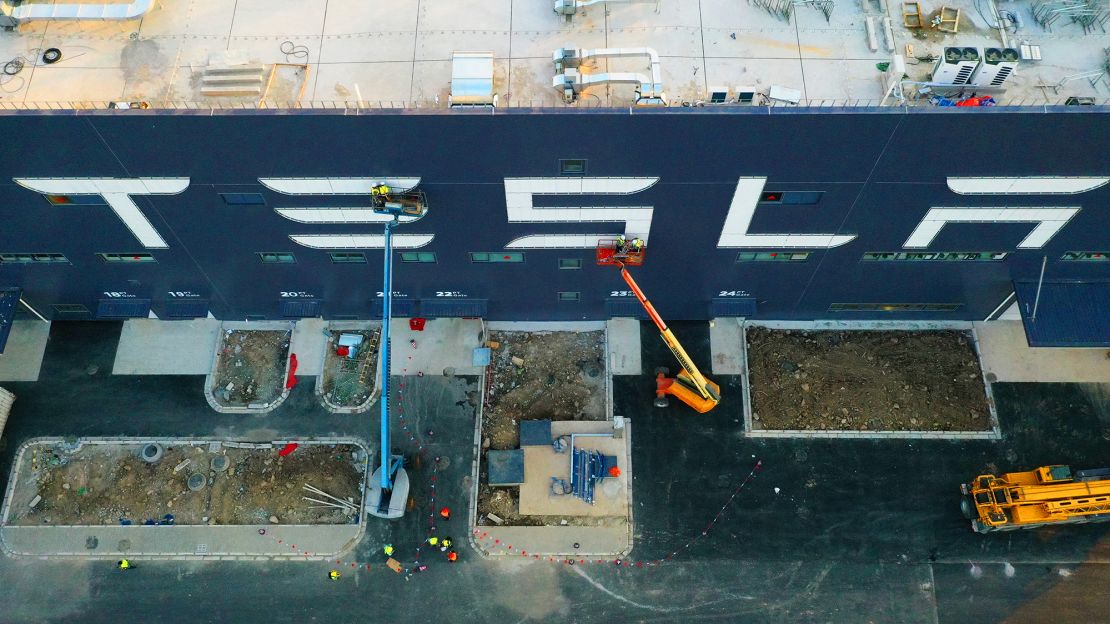Tesla CEO Elon Musk is pushing ahead with global expansion plans after beating his deadline to start making cars in China.
The company told investors Wednesday that Tesla’s (TSLA) new Gigafactory in Shanghai started trial production “ahead of schedule” this month and is building “full vehicles, from body to paint to general assembly.” And thecompany plans to announce the location of its next Gigafactory in Europe by the end of the year, Musk added.
A couple of sprawling, international production plants will likely be critical to Tesla’s future. Easier access to major global car markets — China is the world’s largest — could give the company tens of millions of potential new customers. And success for Tesla in China and elsewhere could boost confidence that the company has the ability to hit delivery targets as it grows.
The Shanghai factory is also notable for how quickly it came together. It was only 10 months ago that Tesla broke ground on the plant. And in a letter to shareholders, the company said the facility was about 65% cheaper to build than its Model 3 productionplant in the United States.
“We havealso dramatically improved the pace of execution and capital efficiency of new production lines,” the company said in its letter.
Musk even implied that the Shanghai factory could become the new normal for Tesla. He called it the “template for future growth.”
Investors are encouraged by Tesla’s progress. The stock is still down more than 23% this year, but solid earnings for the third quarter, including an unexpected profit, sent shares soaring 20%after hours on Wednesday.
“I’m very impressed,” said Tu Le, founder of Beijing-based consulting firm Sino Auto Insights, of the Shanghai plant. “Living in China, nothing [usually] happens that fast.”
Tesla didn’t get there without help.Le pointed out that the company has gotten significant support from the Chinese government in the last year.It was the first foreign automaker to be allowed to open a factory in the country without a Chinese partner, and it recently won a tax break for some of its cars.

If all goes according to plan, Musk says the Shanghai plant could enable Tesla to eventually triple its overall output. It’s expected to produce the best-selling Model 3 along with the Model Y, a cheaper version of Tesla’s Model X SUV that’s on its way to market.
Tesla has said the initial goal for the Shanghai factory is to make 250,000 cars a year before ramping up to 500,000 units.
That’s welcome news for a company entering the fourth quarter with an order backlog.
“This is kind of working out well for Elon Musk’s long-term strategy forward,” Le said. “His goal for Tesla was to really alter the traditional automotive sector, right? And I think you have to be a volume seller in order to do that.”
While the company has built momentum in China, success may not come easy. China’s car market has been in a slump, and that decline has been exacerbated this year by a slowing global economy.
And while Tesla has strong international brand recognition, Le said, it faces fierce competition from local and international players. The company has in the past refused to advertise, spending the money instead on developing the product and letting the cars speak for themselves. That may have to change.
“I think they’re going to have start spending marketing dollars in China,” Le said.
He also warned that Tesla will also have to pull off a “flawless launch” of its Chinese-made vehicles as they roll off the production line in the next few months. Otherwise, the company risks losing trust with consumers.
Put simply, the stakes are high.
“China’s just a huge market, versus the United States and [Europe], which are much smaller markets,” Le said. “If he doesn’t do well in China, then he doesn’t hit his goals,” Le said.


























